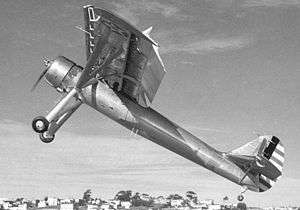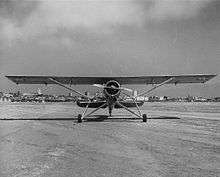Ryan YO-51 Dragonfly
The Ryan YO-51 Dragonfly was an observation aircraft designed and built by Ryan Aeronautical for the United States Army Air Corps (USAAC). A single-engined parasol wing monoplane, it was designed for optimum STOL capability, but although three prototypes proved highly successful in testing, the Stinson YO-49 was judged superior and no production contract was placed.
| YO-51 Dragonfly | |
|---|---|
 | |
| Role | Army observation and liaison |
| Manufacturer | Ryan Aeronautical |
| First flight | 1940 |
| Primary user | United States Army Air Corps |
| Number built | three |
Design
The design of the YO-51 Dragonfly was typical for aircraft of its type, being optimised for the observation and liaison role, with emphasis on the ability to operate out of the smallest possible airfields.[1] The Dragonfly was a high-wing braced parasol monoplane with fixed tailwheel landing gear, a two-seat open cockpit, and full-span slots and Fowler flaps for STOL capability.[2] It was powered by a single Pratt & Whitney R-985-21 Wasp Junior radial engine.[3]
At gross weight, the YO-51 could, without flaps, take off after a run of 400 feet, while with full flaps the takeoff run would be only 75 feet, or just four feet more than twice its own length.[4] The Dragonfly was capable of maintaining level flight at speeds as low as 30 miles per hour (48 km/h),[5] and was claimed as being capable of landing in a distance shorter than the length of the aircraft itself.[6]
Operational history
Nicknamed the "flying motorcycle",[7] three YO-51 aircraft were acquired by the United States Army Air Corps to take part in a fly-off evaluation against the Stinson YO-49 and Bellanca YO-50 to supply a new observation and liaison aircraft for use by the USAAC.[8] The YO-51 was the heaviest of the three aircraft evaluated.[9]
Although the Dragonfly was considered satisfactory during its flight testing,[10] conducted at Wright Field in Ohio,[11] the Stinson machine won the production contract, and no further YO-51s were built.[12]
Specifications

Data from Donald 1997[3]
General characteristics
- Crew: two (pilot and observer)
- Length: 35 ft 6 in (10.82 m)
- Wingspan: 52 ft (16 m)
- Height: 11 ft 1 in (3.38 m)
- Gross weight: 4,206 lb (1,908 kg)
- Powerplant: 1 × Pratt & Whitney R-985-21 Wasp Junior radial, 440 hp (330 kW)
Performance
- Maximum speed: 129 mph (208 km/h, 112 kn)
- Cruise speed: 107 mph (172 km/h, 93 kn)
- Stall speed: 30 mph (48 km/h, 26 kn)
Armament
- None
See also
Aircraft of comparable role, configuration and era
- Bellanca YO-50
- Stinson L-1 Vigilant
- Fieseler Fi 156
- Levente II
- Po-2
- Henschel Hs 126
- Kokusai Ki-76
Related lists
References
- Notes
- Penfield 1941, p.31.
- Foottit, H. R. (February 1942). "The Fowler Flap". Flying and Popular Aviation. Chicago: Ziff-Davis Publishing Co. 30 (2): 71.
- Donald 1997, p.794.
- Fowler 1948, p.79.
- Rowe 2006, p.22.
- Wilson, Gill Robb (July 1954). "Genealogy of American Aircraft". Flying. Chicago: Ziff-Davis Publishing Co. 55 (1): 23.
- "U. S. Army's "Flying Motorcycle"". The Boston Globe. Boston, MA. May 25, 1941. p. C1.
- Pattillo 2001, p.137.
- Adcock 2005, p.5.
- "The Dragonfly---Army's Newest Observation Plane". The Milwaukee Sentinel. Milwaukee, WI. February 23, 1940. p. 2.
- "Army Tests New B-17C". The New York Times. New York. November 17, 1940. Retrieved 2012-08-11.
- Merriam 2002, p.26.
- Bibliography
- Adcock, Al (2005). US Liaison Aircraft in action. Aircraft in Action. 195. Carrollton, TX: Squadron/Signal Publications. ISBN 978-0897474870.
- Donald, David (1997). Complete Encyclopedia of World Aircraft. London: Orbis Publishing Ltd. ISBN 0760705925.
- Fowler, Harlan Davey (1948). Fowler Flaps for Airplanes: An engineering handbook. Los Angeles: Wetzel Publishing Co. ASIN B0007EA17Q.
- Merriam, Ray, ed. (2002). World War II Journal #15: U.S. Military Aircraft of World War II. Bennington, VT: Merriam Press. ISBN 1576381676.
- Pattillo, Donald M. (2001). Pushing the Envelope: The American Aircraft Industry. Ann Arbor, MI: University of Michigan Press. ISBN 978-0472086719.
- Penfield, Thomas (1941). Wings for America: Fighting Planes of the U. S. A. Chicago: Rand McNally & Co. ASIN B004BVUSC4.
- Rowe, Frank Joseph (2006). The Helio Courier Ultra C/stol Aircraft: An Illustrated Developmental History. Jefferson, NC: McFarland & Company. ISBN 978-0786422890.
External links
| Wikimedia Commons has media related to YO-51 Dragonfly. |
- O-51 Dragonfly at Dave's Warbirds